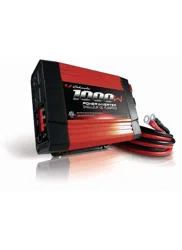Loading ...
Loading ...
Loading ...

• 5 •
1.17 Do not operate the inverter with damaged cables; have the cables replaced immediately by
a qualied service person.
1.18 Do not operate the inverter if it has received a sharp blow, been dropped or otherwise
damaged in any way; take it to a qualied service person.
1.19 Do not disassemble the inverter; take it to a qualied service person when service or repair
is required. Incorrect reassembly may result in a risk of re or electric shock.
1.20 Working in the vicinity of a lead-acid battery is dangerous. Batteries generate explosive
gases during normal battery operation. For this reason, it is of utmost importance that you
follow the instructions each time you use the inverter.
1.21 This inverter employs parts, such as switches and circuit breakers, that tend to produce
arcs and sparks. If used in a garage, locate this inverter 18 inches (46 cm) or more above
the oor level.
1.22 Do not use the inverter with a product that draws a higher wattage than the inverter can
provide, as this may cause damage to the inverter and product.
2. INVERTER FEATURES
1. AC outlets
2. Digital display
3. LED Indicators (green):
• DC input voltage
• Output wattage (kW)
• Output wattage (W)
4. USB port
5. ON/OFF button
6. Remote control port
(Remote control sold separately)
5
2 3
1 4
6
3. BEFORE USING YOUR POWER INVERTER
NOTE: Do not use the inverter with a product that draws a higher wattage than the inverter
can provide, as this may cause damage to the inverter and product.
When you turn on a device or a tool that runs on a motor, the device goes through two stages:
1. Start Up – Requiring an initial surge of power (commonly known as the “starting” or
“peak” load).
2. Continuous Operation – Power consumption drops (commonly known as “continuous load”).
The wattage (WATTS) or amperes (AMPS) can normally be found stamped or printed on
most devices and equipment, or in the user’s manual. Otherwise, contact the manufacturer
to nd out whether the device you want to use is compatible with a modied sine wave.
To calculate the wattage: Wattage = AMPS x 110 (AC Voltage).
To calculate the starting load: Starting Load = 2 x WATTS. In general, the start up load
of the device or power tool determines whether or not your inverter has the capability to
power it.
To calculate the continuous load: Continuous Load = AMPS x 110 (AC Voltage).
IMPORTANT
Always run a test to establish whether or not the inverter will operate a
particular piece of equipment or device. In the event of a power overload,
the inverter is designed to automatically shut down. This safety feature prevents damaging
the inverter while testing devices and equipment within the wattage range of the inverter.
If a device does not operate properly when rst connected to the inverter, turn the inverter On/
Off switch ON, OFF, and ON again in quick succession. If this procedure is not successful, it is
likely that the inverter does not have the required capacity to operate the device in question.
Loading ...
Loading ...
Loading ...
